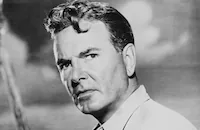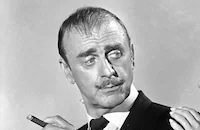Lady in the Iron Mask
Cast & Crew
Ralph Murphy
Louis Hayward
Patricia Medina
John Sutton
Steve Brodie
Alan Hale Jr.
Film Details
Technical Specs

Synopsis
In the 17th century, D'Artagnan, the former captain of Louis XIII's musketeers, is aboard a ship bound for America and bemoans the fact that he is married to a woman he does not love. As he ponders his fate, D'Artagnan remembers how he became embroiled in this predicament: After the king dies, France is thrown into turmoil, and the king's power-hungry brother-in-law, the Duc de Valdac, becomes regent. De Valdac plots to marry Princess Anne to the pliant Philip of Spain and wrest control from the ailing prime minister, Rochard. Alarmed that a foreigner will sit on the throne, D'Artagnan gathers his old comrades, Athos, Aramis and Porthos, and travels to Paris to see Anne. De Valdac's guards refuse them entry, and the musketeers are challenged by D'Artagnan's nemesis, the Count de Fourrier. D'Artagnan is surprised when, instead of fighting, de Fourrier escorts him to see the prime minister. Rochard reveals to D'Artagnan that when Anne was born twenty years ago, she was one of identical twin girls. Worried that the line of succession would be jeopardized, Rochard persuaded the king to allow the midwife to rear the other twin, Louise, as her own daughter. When the midwife died, Rochard had Louise imprisoned in a dungeon, where she has been for two years. To disguise her identity, Louise has been forced to wear an iron mask, and Rochard fears that de Valdac learned of her existence, and after freeing her, imprisoned Anne in her place. D'Artagnan is skeptical, but Rochard insists that Anne would never marry Philip, and so it must be Louise who is now occupying the throne. Rochard instructs D'Artagnan to locate the imprisoned princess and determine if she is Anne, who has a birthmark on her thigh. D'Artagnan and his friends then infiltrate the princess' chamber and are surprised when she fails to recognize them. De Valdac has them removed from the building, then sends off two messengers. Knowing that the messengers are heading for Anne's captors, D'Artagnan and his men follow them. All of them are apprehended except D'Artagnan, who waylays one of the messengers and finds a letter from de Valdac to Chevalier La Porte, the commandant of the Chateau de Vallons, ordering him to kill his prisoner. D'Artagnan frees his companions and then proceeds to the chateau. There, D'Artagnan and Porthos gain entry and convince La Porte to show the prisoner to them. Horrified to see the princess in the iron mask, D'Artagnan orders La Porte to remove it, and after a fierce fight with the chateau's guards, the musketeers ride off with her. The next morning, D'Artagnan devises a plan to re-enter Paris by disguising the princess as his servant boy, and having Porthos and Athos travel as a farmer and his wife. While a grumbling Athos shaves his mustache, he demands that D'Artagnan ascertain that they have the correct princess, and as D'Artagnan reluctantly spies on the woman as she dons breeches, he sees the birthmark on her thigh, identifying her as Anne. Porthos and Athos then stop at an inn, where they hope to distract the soldiers searching for a man and woman traveling together, while D'Artagnan and Anne begin the trek home. D'Artagnan is impressed by Anne's resilience, and when they rest for the night, they confess their love for each other. The next day, D'Artagnan and Anne meet the musketeers outside Paris, and ambush a carriage belonging to Philip's uncle. Hiding within, D'Artagnan and Anne gain entry to Paris, although Anne begs him to run away with her to England. D'Artagnan urges her to be strong for her country, and Anne realizes that they must sacrifice their desires for the good of France. In Paris, the group travels to the shop of dressmaker Madame Duprez, who is devoted to Anne. Madame Duprez smuggles a rope ladder into the palace, and soon D'Artagnan, Anne and the others have snuck into the royal chambers. Anne accidentally drops her handkerchief in the garden, though, alerting de Valdac to her presence. While De Valdac gathers his guards, Anne meets her sister for the first time, and the terrified Louise reveals that de Valdac lied, telling her that Anne was responsible for her imprisonment. D'Artagnan and Anne assure her of their friendship and desire to help, but before they can proceed, de Valdac and his men arrive. While the other musketeers battle the soldiers, D'Artagnan and de Valdac engage in an intense swordfight. D'Artagnan prevails, and soon Rochard's forces arrive to arrest the remaining traitors. Rochard offers D'Artagnan a reward, but when D'Artagnan states that he wants nothing, Anne offers him her hand in marriage. Rochard protests, telling Anne that she is obliged to marry a noble, and she and Louise retire to the bedroom to discuss the matter. When the sisters emerge, Anne decrees that she will announce her engagement to a French aristocrat, then orders D'Artagnan to accompany Louise to America, where she will be safe, and to marry her. Back aboard the ship, D'Artagnan's musings come to an end when Louise summons him. She is dismayed when he formally asserts that theirs is a marriage of state only, but realizes that it is because he is deeply in love with Anne. As D'Artagnan is leaving the cabin, however, his sword catches on the princess' gown, tearing off her skirt. Anne's birthmark is revealed, and an ecstatic D'Artagnan embraces his bride.

Director
Ralph Murphy
Cast

Louis Hayward
Patricia Medina

John Sutton

Steve Brodie

Alan Hale Jr.
Judd Holdren
Hal Gerard
Robert Bice
Lester Matthews

John Dehner
Gavin Muir
Marlyn O'dwyer
Tor Johnson
Keith Hitchcock
Esther Howard
Crew
Victor Appel
Milton Carter
Lonnie D'orsa
Elmer Ellsworth
George Emick
Eugene Frenke
Wilton R. Holm
Hazel Keats
Ernest Laszlo
Martin Obzina
Bruce Pierce
Jack Pollexfen
Jack Pollexfen
Norman Pringle
Clifford D. Shank
Dimitri Tiomkin
Richard Walton
Walter Wanger
Merrill White
Aubrey Wisberg
Aubrey Wisberg
Yvonne Wood
Al Zimbalist

Film Details
Technical Specs

Quotes
Trivia
Notes
This film's opening title cards read: "A Walter Wanger Production An Adaptation from Alexandre Dumas' Lady in the Iron Mask Based upon 'The Three Musketeers.'" Dumas did not write any works entitled Lady in the Iron Mask, however, nor do the characters of "Princess Anne" and "Princess Louise" appear in his books. Jack Pollexfen's surname is misspelled "Pollexin" in the opening credits. Pollexfen's and Aubrey Wisberg's credit reads: "Associate Producers and Original Screenplay by Jack Pollexin, Aubrey Wisberg."
According to a September 19, 1951 Hollywood Reporter news item, Barbara Payton was originally set for the leading role but withdrew from the production after her doctor advised her that she was "too emotionally upset to undertake the role." A September 19, 1951 Los Angeles Daily News news item reported, however, that the real reason Payton did not appear in the film was the notoriety surrounding her romances with actors Franchot Tone and Tom Neal. On September 14, 1951, the night before she was to marry Neal, Payton, who had previously been engaged to Tone, was on a date with Tone, and Neal, a former Golden Gloves boxing champion, beat Tone into unconsciousness, causing him to suffer a concussion, broken nose, fractured cheekbone and numerous lacerations. On September 28, 1951, Payton married Tone, although the marriage lasted for only six months and Tone threatened to charge Payton with adultery with Neal if she did not agree to the divorce.
Although Hollywood Reporter news items and production charts include Selene Walters, Leo Mostovoy and Gerald Oliver Smith in the cast of Lady in the Iron Mask, their appearance in the completed picture has not been confirmed. Hollywood Reporter also includes Paul Cavanagh in the film, but it is unlikely that he appears in the released picture. Among the many films based on Dumas' book are the 1939 United Artists release The Man in the Iron Mask, which was directed by James Whale and starred Louis Hayward as the twin princes, Joan Bennett and Alan Hale, Sr. as "Porthos." For more information about the 1939 production, and other films based on Dumas' book, please see the entry for The Man in the Iron Mask in AFI Catalog of Feature Films, 1931-40.












